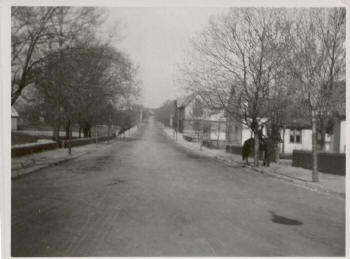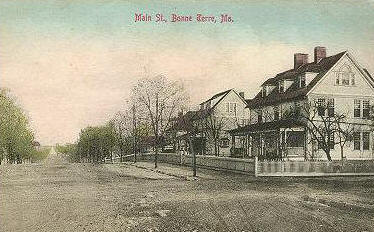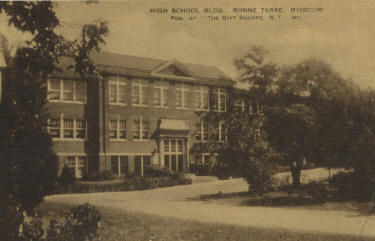FRANCES DUNN
|
TOWN & BUSINESS INDEX PAGE
HOME PAGE
FRANCES DUNN
|
'The Town That Didn't Quit and Didn't Die'By Peggy O'Farrell
|
|
Or she can tell you what she remembers best of her hometown, augmented
by her years of research, and that can be more interesting than names and dates pulled out
of a dusty book.
 |
"My favorite memories of Bonne Terre I think probably would be the fun that we used to have at the old bandstand, which was right across the street from here (her home on School Street)," she said. "They had a band concert every week. Everybody came to it. There weren't many cars back then, and the people walked, and you could walk around the bandstand.
|
|
"Mr. Parsons was a musician and anybody that could play a musical instrument, they hired, because he wanted them for the band. As time went on, there was different ones that played in the band. And everybody looked forward to it, Friday nights at the band concert. It was just a hometown thing that we all appreciated.
"We had the picture show, which everybody went to. They went to church on Sunday morning, then to the picture show on Sunday afternoon, and then back to church Sunday night.
"And I remember my high school days, playing on the basketball team," Mrs. Dunn continued.
"I never will forget, I was a freshman, and we wore serge, either navy blue or black bloomers, and we made the tops, either red or white. That was the year that the other schools came out with shorts, and we went up to Herculaneum and they made fun of us because we still wore bloomers. And we had red and white wool socks and they wanted us to pull the socks up and pull the legs of our bloomers down so our legs wouldn't show.
"Then when I was a sophomore, we decided we wanted shorts, too, and so we had a benefit bake sale and benefit show until we raised enough money for them.
"We got them, and they were long-length, and they still wanted us to pull them down so they covered our knees! So we fixed them so we could pull them up, and then blouse them down so they would look like shorts.
"We were at Herculaneum one night, and our principal Mr. Wells--we always called him Pop Wells--was there. Well, when you get to playing, your socks fall down, and we would pull our bloomers up. Pop came in to the locker room. I never will forget what he said. He said, 'I want you girls to pull your bloomers down!' And when he realized what he said, his face got real red, and out he went."
Like many people in Bonne Terre, she takes pride in the historic buildings and homes
that fill the town. "I don't think there's any prettier town than Bonne Terre,
especially Church Street and Main Street in the spring and in the fall. Mr. Parsons and
Mrs. Sheperd and Mr. Jones set the town out and they used the maple trees, and you can see
the old maples.
 |
I grew up on Main Street, and I don't think there's any two prettier streets any place, with the big palatial homes, and they're all well taken care of."
Her father, George Spain, was dispatcher for the old Mississippi River and Bonne Terre
railroad, and for the Missouri-Illinois line, and she travelled all over the area by
train.
|
She remembers the mining days, and parts of the 1917 riots, when the train "just happened to be waiting there with those box cars to carry those people out. I've always wondered if my father knew anything about what was coming, and sent them out." "Bonne Terre is actually a melting pot of all the different nationalities that lived here then," Mrs. Dunn said. Things are peaceful now, she says, but when the immigrant miners first arrived, that was not the case. "The people that lived up on (Hunky Hill), the company built them houses. They were three-room houses, two rooms down and one up, and everybody had a boarder. The people that lived up in town more or less resented those people because they had new homes, and they were used to their drink, which they were allowed to have, and they couldn't have anything down here like they had up there. And there were hard feelings."
The lead companies were strict in the early days," she said, as they owned all the land and could spell out right in the deed what would be allowed and what wouldn't. "You couldn't have a dairy, and you couldn't have a slaughterhouse. You couldn't have a bawdy house," she said. "Everything west of what's now Division Street was in the boonies, so that's where all the saloons were. And that's why there still out there now."
She can tell you about the WPA crews rocking and concreting and covering the sewers--"that was a real improvement for the town"--the battle over whether to end open range for livestock in town--"you had to keep a fence around your place, or you'd find cattle and pigs and chickens all over the place"--and the election of the first mayor in 1917.
"St. Joe and Mr. Parsons had the foresight to see what the town needed. The
schools were always first-class. But it wasn't until Robert Sellors, the first mayor, that
the town really started changing."
 |
A police force took the place of the night watchman, a cash-and-carry store was set up in favor of the company store and St. Joe was getting back to the business of lead-mining, and away from government. "You could see Bonne Terre was actually growing," she said.
|
And she remembers when St. Joe pulled out, and the fear that gripped Bonne Terre. "They were whipped," she said. "They didn't know which way to turn. All they could see was doom, but fortunately, we had people, again, who had the foresight to get Bonne Terre together. We survived. And I think Bonne Terre now is financially and morally stronger than it was when St. Joe was here. Because they have learned to stand on their own two feet and fight for what they want. That's what you get out of life. If you're going to amount to anything, you have to fight for what you want.
"I'm proud of Bonne Terre, the town that didn't quit and didn't die. Everybody said that we would become a ghost town, which we did not."
And she's realistic, too. "There's no use saying we're ideal, because we're not. We've had our saloons, and our fights and our quarrels. I always laugh at people who don't want to be reminded of these things, because they happened.
"I know people think people in Bonne Terre are self-centered, but we're not. We make our mistakes, but we don't want anybody to come in and tell us that we made them. We'll correct them ourselves when we get around to it," she said.
Mrs. Dunn is in her third term as president of Bonne Terre's historical society, and in the middle of another book on the town--"some day I'll get back to it, but right now, I'm too busy" and looking for more town history to dig up and write down.
"There's history wherever you look, if you'll just dig for it. We don't pay much attention to it, but if you really want to find out what happened way back when, there'll always be somebody who can tell you or tell you where to look for it. I think that's what so fascinating about being interested in historical things. Or maybe I'm just proud of Bonne Terre."
TOWN & BUSINESS INDEX PAGE
The information on this site is provided free for the purpose of researching your genealogy. This material may be freely used by non-commercial entities, for your own research. The information contained in this site may not be copied to any other site without written "snail-mail" permission. If you wish to have a copy of a donor's material, you must have their permission. All information found on these pages is under copyright of Oklahoma Cemeteries. This is to protect any and all information donated. The original submitter or source of the information will retain their copyright. Unless otherwise stated, any donated material is given to MOGenWeb to make it available online.